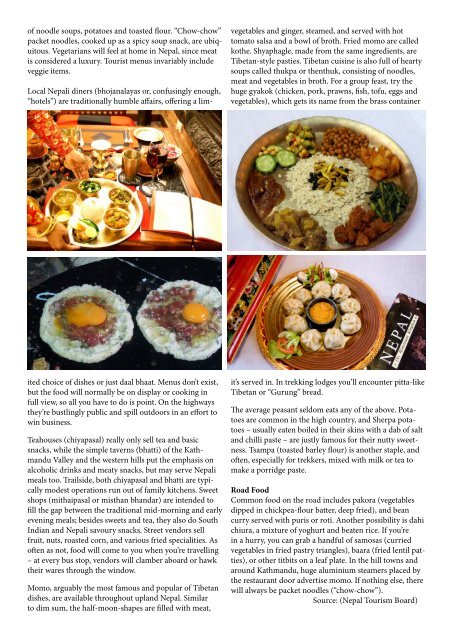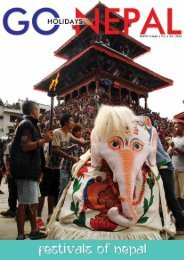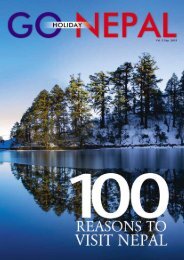Go Nepal e-Magazine
Go Nepal Holiday
Go Nepal Holiday
Create successful ePaper yourself
Turn your PDF publications into a flip-book with our unique Google optimized e-Paper software.
of noodle soups, potatoes and toasted flour. “Chow-chow”<br />
packet noodles, cooked up as a spicy soup snack, are ubiquitous.<br />
Vegetarians will feel at home in <strong>Nepal</strong>, since meat<br />
is considered a luxury. Tourist menus invariably include<br />
veggie items.<br />
vegetables and ginger, steamed, and served with hot<br />
tomato salsa and a bowl of broth. Fried momo are called<br />
kothe. Shyaphagle, made from the same ingredients, are<br />
Tibetan-style pasties. Tibetan cuisine is also full of hearty<br />
soups called thukpa or thenthuk, consisting of noodles,<br />
meat and vegetables in broth. For a group feast, try the<br />
huge gyakok (chicken, pork, prawns, fish, tofu, eggs and<br />
vegetables), which gets its name from the brass container<br />
Local <strong>Nepal</strong>i diners (bhojanalayas or, confusingly enough,<br />
“hotels”) are traditionally humble affairs, offering a limited<br />
choice of dishes or just daal bhaat. Menus don’t exist,<br />
but the food will normally be on display or cooking in<br />
full view, so all you have to do is point. On the highways<br />
they’re bustlingly public and spill outdoors in an effort to<br />
win business.<br />
Teahouses (chiyapasal) really only sell tea and basic<br />
snacks, while the simple taverns (bhatti) of the Kathmandu<br />
Valley and the western hills put the emphasis on<br />
alcoholic drinks and meaty snacks, but may serve <strong>Nepal</strong>i<br />
meals too. Trailside, both chiyapasal and bhatti are typically<br />
modest operations run out of family kitchens. Sweet<br />
shops (mithaipasal or misthan bhandar) are intended to<br />
fill the gap between the traditional mid-morning and early<br />
evening meals; besides sweets and tea, they also do South<br />
Indian and <strong>Nepal</strong>i savoury snacks. Street vendors sell<br />
fruit, nuts, roasted corn, and various fried specialities. As<br />
often as not, food will come to you when you’re travelling<br />
– at every bus stop, vendors will clamber aboard or hawk<br />
their wares through the window.<br />
Momo, arguably the most famous and popular of Tibetan<br />
dishes, are available throughout upland <strong>Nepal</strong>. Similar<br />
to dim sum, the half-moon-shapes are filled with meat,<br />
it’s served in. In trekking lodges you’ll encounter pitta-like<br />
Tibetan or “Gurung” bread.<br />
The average peasant seldom eats any of the above. Potatoes<br />
are common in the high country, and Sherpa potatoes<br />
– usually eaten boiled in their skins with a dab of salt<br />
and chilli paste – are justly famous for their nutty sweetness.<br />
Tsampa (toasted barley flour) is another staple, and<br />
often, especially for trekkers, mixed with milk or tea to<br />
make a porridge paste.<br />
Road Food<br />
Common food on the road includes pakora (vegetables<br />
dipped in chickpea-flour batter, deep fried), and bean<br />
curry served with puris or roti. Another possibility is dahi<br />
chiura, a mixture of yoghurt and beaten rice. If you’re<br />
in a hurry, you can grab a handful of samosas (curried<br />
vegetables in fried pastry triangles), baara (fried lentil patties),<br />
or other titbits on a leaf plate. In the hill towns and<br />
around Kathmandu, huge aluminium steamers placed by<br />
the restaurant door advertise momo. If nothing else, there<br />
will always be packet noodles (“chow-chow”).<br />
Source: (<strong>Nepal</strong> Tourism Board)









